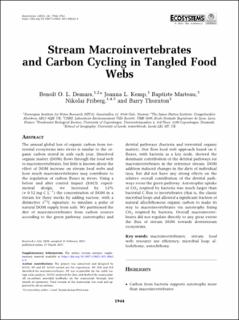| dc.contributor.author | Demars, Benoît Olivier Laurent | |
| dc.contributor.author | Kemp, Joanna Lynn | |
| dc.contributor.author | Marteau, Baptiste | |
| dc.contributor.author | Friberg, Nikolai | |
| dc.contributor.author | Thornton, Barry | |
| dc.date.accessioned | 2022-03-11T08:56:09Z | |
| dc.date.available | 2022-03-11T08:56:09Z | |
| dc.date.created | 2022-02-16T15:27:07Z | |
| dc.date.issued | 2021 | |
| dc.identifier.citation | Ecosystems. 2021, 24 (8), 1944-1961. | en_US |
| dc.identifier.issn | 1432-9840 | |
| dc.identifier.uri | https://hdl.handle.net/11250/2984507 | |
| dc.description.abstract | The annual global loss of organic carbon from terrestrial ecosystems into rivers is similar to the organic carbon stored in soils each year. Dissolved organic matter (DOM) flows through the food web to macroinvertebrates, but little is known about the effect of DOM increase on stream food webs and how much macroinvertebrates may contribute to the regulation of carbon fluxes in rivers. Using a before and after control impact (BACI) experimental design, we increased by 12% (+ 0.52 mg C L−1) the concentration of DOM in a stream for three weeks by adding sucrose, with a distinctive δ13C signature, to simulate a pulse of natural DOM supply from soils. We partitioned the diet of macroinvertebrates from carbon sources according to the green pathway (autotrophs) and detrital pathways (bacteria and terrestrial organic matter). Our flow food web approach based on C fluxes, with bacteria as a key node, showed the dominant contribution of the detrital pathways for macroinvertebrates in the reference stream. DOM addition induced changes in the diets of individual taxa, but did not have any strong effects on the relative overall contribution of the detrital pathways versus the green pathway. Autotrophic uptake of CO2 respired by bacteria was much larger than bacterial C flux to invertebrates (that is, the classic microbial loop) and allowed a significant fraction of natural allochthonous organic carbon to make its way to macroinvertebrates via autotrophs fixing CO2 respired by bacteria. Overall macroinvertebrates did not regulate directly to any great extent the flux of stream DOM towards downstream ecosystems. | en_US |
| dc.language.iso | eng | en_US |
| dc.publisher | Springer | en_US |
| dc.rights | Navngivelse 4.0 Internasjonal | * |
| dc.rights.uri | http://creativecommons.org/licenses/by/4.0/deed.no | * |
| dc.title | Stream Macroinvertebrates and Carbon Cycling in Tangled Food Webs | en_US |
| dc.type | Peer reviewed | en_US |
| dc.type | Journal article | en_US |
| dc.description.version | publishedVersion | en_US |
| dc.source.pagenumber | 1944-1961 | en_US |
| dc.source.volume | 24 | en_US |
| dc.source.journal | Ecosystems | en_US |
| dc.source.issue | 8 | en_US |
| dc.identifier.doi | 10.1007/s10021-021-00626-8 | |
| dc.identifier.cristin | 2002443 | |
| cristin.ispublished | true | |
| cristin.fulltext | original | |
| cristin.qualitycode | 2 | |

